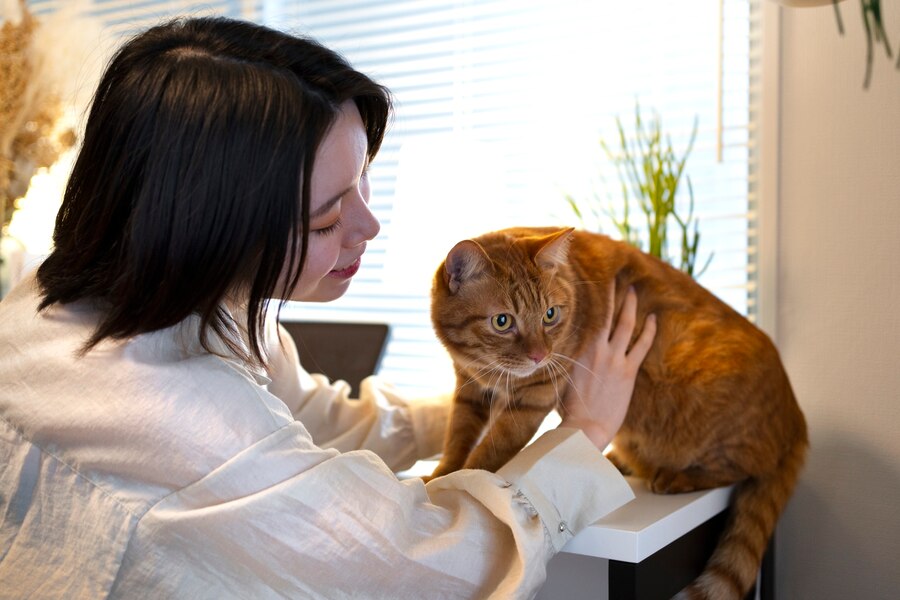Decoding Cat Body Language: Understanding Cat Behavior For Effective Communication


Cats have been fascinating humans with their enigmatic body language for centuries. Their primary mode of communication, “meow,” can mean a lot of things. Their various tone, pitches, and frequencies mean something different every time.
This is an intriguing part of cat body language, and this does not just mean that they are trying to communicate with their hoomans. Moreover, it reflects their desires and emotional state of mind.
Understanding their language and vocalization is an important part of pet care. Unlike dogs, who have a more direct approach to communication, cats are subtle. A meow can mean they want your attention, they are in pain, they are hungry or curious about something.
This is why it is important that you understand their body language for effective communication. Also, this will improve your bond with your feline friend.
Understanding Your Cat’s Body Language
Cats are a lot like human beings. They reveal their inner state through their body language. Also, they have their own cat body language to communicate their emotions and thoughts. They use both their body and voice to show how they are feeling and what they are thinking.
When you learn their boy language, you will be able to communicate with them better and know what they want. However, you have to ensure that you focus on everything that is happening around the cat.
You have to think of the smell, the sight, and the sounds that are around, and then think what they might be thinking.
Tail Movements And Their Meanings
You can understand a cat’s mood from their tail. Here is how it goes:
- An upright, high tail means a cat is confident, happy
- When their tail is tucked between their legs, it means they are scared or submitting to someone.
- If their tail is puffed up, it means they feel threatened by something and are trying to appear larger than they are.
- Moreover, if they are waving their tail gently, it means they are focused and possibly playing or hunting.
- If they are rapidly twitching their tail, it can mean they are impatient and irritated.
Ear Positions And Eye Contact
Ears are one of the most expressive parts of their anatomy. Here is how you can understand their mood from their ears.
- If you notice their ears facing forward, it means they are interested or curious about something.
- However, if their ears are flattened, it is a sign of aggression or fear.
- From the direction of their ears, you will get to know whether they are focused or not.
Moreover, if they blink slowly, it is a sign of trust and attention. This is often linked to a “cat kiss.” But if they are staring at something for quite a while, it could mean they are challenging something or considering something as a threat.
Fur And Whisker Changes
Everything about a cat talks if you just know how to listen. They are always leaving clues about their emotional state.
- When you see their fur standing at the end, it means they are scared or feel threatened by something. They are just trying to appear larger than they are.
- If you see their whiskers relaxed and pointing away from their face, this means they are calm and content.
- If their whiskers are pointing forward, it is a sign of aggression or excitement.
You must understand these signs. This helps you have a harmonious relationship with your feline friend. Moreoevr, if you know what they are going through, you will be able to show compassion in a way that they need.
Know that every cat is unique. The more time you spend with your cat, the better you will know them.
The Vocal Cat: Deciphering Meows And Purrs
Cats communicate a great deal through their vocalizations, and understanding these sounds can significantly improve the relationship between a cat and its owner.
Each meow, purr, hiss, or chirp has a specific meaning, and learning to interpret these can be both fascinating and rewarding. If you are wondering, “why is my cat meowing so much,” there is a separate set of reasons behind that as well.
Different Types Of Meows And What They Mean
A cat’s meow can vary in pitch, volume, and duration, and each variation can indicate a different need or emotion. A short, high-pitched meow is often a greeting, while multiple meows may signal excitement.
A mid-pitched meow might be a request for food or attention, and a low-pitched meow can indicate discomfort or annoyance. Cats also use meows to alert their owners to potential dangers or to express loneliness.
Purring: More Than Just Contentment
A cat often purrs when it is happy, but this is not limited to expressing contentment. Moreover, they purr when they are in pain, when they are frightened, and even when they are close to death.
Purring is a self-soothing behavior. When they are in distress, they purr a lot. It is believed that purring releases endorphins, which help relieve pain or relax.
Other Vocalizations: Hisses, Growls, And Chirps
A cat hissing is generally a sign of aggression or fear and is a sign of warning. Spitting or growling can mean discomfort, anxiety, or aggression.
However, trills and chirps are mostly used by mothers towards their kittens. Cats often use this to greet humans or when they want attention. If you pay attention to these different sounds, you will be able to understand the context of them making the sound.
You will be able to gain a deeper understanding of their needs and feelings. Again, every cat is unique, and when you spend time listening and observing, you will get better at understanding their language.
Behavior Patterns And Their Interpretations
Cats exhibit a variety of behaviors that can sometimes be puzzling to their human companions. Understanding these behavior patterns is crucial for providing the best care and forming a deeper bond with your feline friend.
Kneading
One common behavior is kneading, where a cat pushes its paws in and out against a soft surface. This action is often a leftover behavior from kittenhood, when kittens used to knead their mom’s belly to stimulate milk flow.
In adult cats, kneading can signify contentment, comfort, and affection. It’s often accompanied by purring and can be a sign that your cat feels safe and loved.
Scratching
Cats scratch for a lot of reasons. They often scratch to mark their territory, as their paws have scent glands and leave a smell behind.
Scratching helps them stretch their muscles and maintain their claw health. If you get them a scratching post and surface, it can prevent unwanted scratching of furniture, and this can satisfy their natural behavior.
Play Behavior vs. Aggression
Learn the difference between their playful behavior and aggression. This is something all cat owners should know. Playful behavior like batting, poncing, and light nibbling is normal, and this helps with their physical and mental stimulation.
However, if it escalates and the matter goes to scratching or biting that causes harm, this could be a sign of aggression. Aggressive behavior can be triggered by territorial disputes, fears, and stress. It is important that you recognize these signs and the reasons behind them.
Changes in Behavior
Always keep an eye on them to notice if there is a change in their behavior. A change in behavior can indicate emotional or health issues.
If there is a decrease in activity, like a change in their sleeping or eating patterns, or sudden aggression, it could mean there is something they are going through. If you notice these changes, they will need a close examination and take them to a vet for consultation.
A Cat’s Behavior Depends On The Environment
When you are trying to decode cat body language or their behavior, you have to consider whether they feel safe in that particular situation or not. Think about whether there is anything in their surroundings that can cause them stress or anxiety.
A confined area, where they might find it difficult to escape, will cause them more stress than any open room where they can see what is surrounding them clearly.
This is why they love to spend time on high open perches. Also, placing the litter box in a secure location is important.
You can provide them with a quality cat tower with a multi-purpose space for them to play, observe, relax, and withdraw when they are feeling overwhelmed.
If your cat is familiar with everyone surrounding them and enjoys a personal spot they know they can take refuge in, it will make them feel safer, and they will be more comfortable there.
On the other hand, when you are traveling with your cat, you can assume they will be a little stressed. So, you will have to choose the right cat carrier for them with visual stimulation and limited noise. Make sure they get light and ventilation in there.
Understand Their Behavior Patterns
When you understand cat body language and their behavior patterns, you will be able to create an understanding and nurturing environment for them. Moreover, you will have to consider their breed history and unique personality.
Cat behavior varies widely. So, if you are unable to understand them or think they are somehow in pain, it is better to consult a professional for guidance.
If you follow the guidelines, as a cat parent, you will be able to understand them better. You will be able to communicate with them better. You will have a harmonious relationship with your fur baby.









All Comments
Mack Jacobi
14 January, 2024
Regular updates and dedicated support.
Reply
Monica
17 January, 2024
Normally I do not read article on blogs however I would like to say that this writeup very forced me to try and do so Your writing style has been amazed me Thanks quite great post
Reply